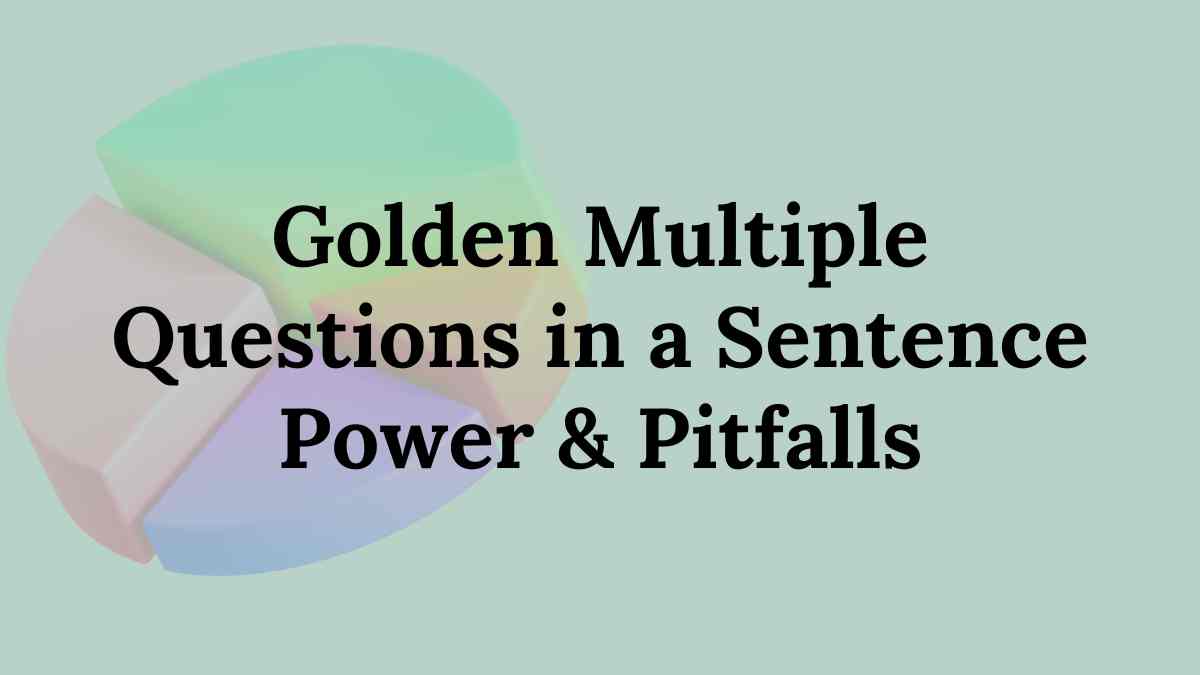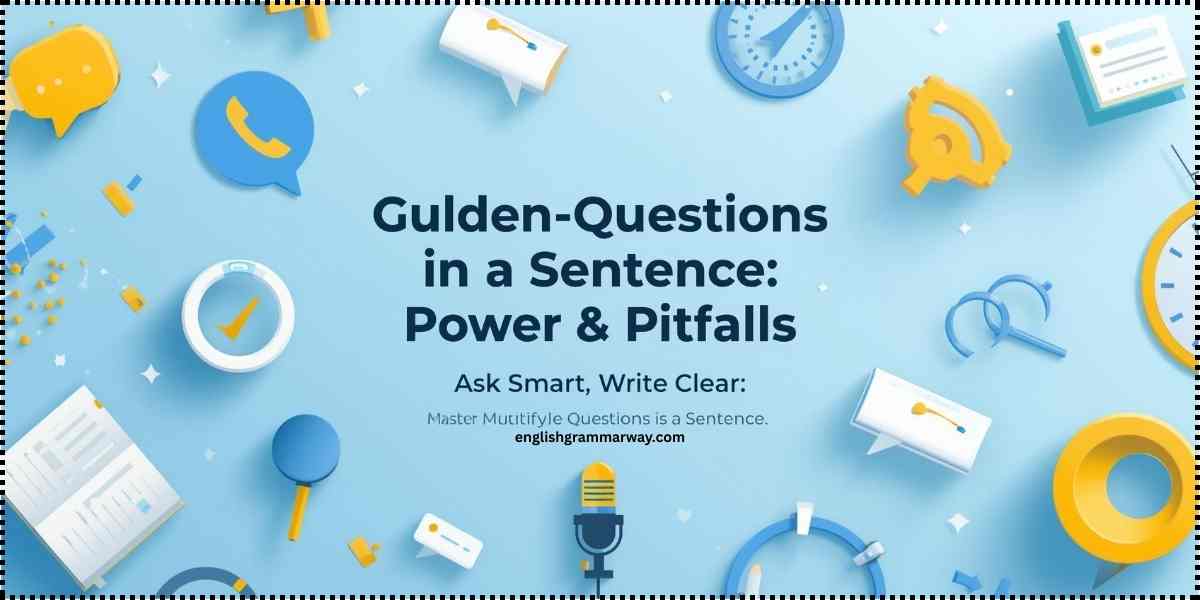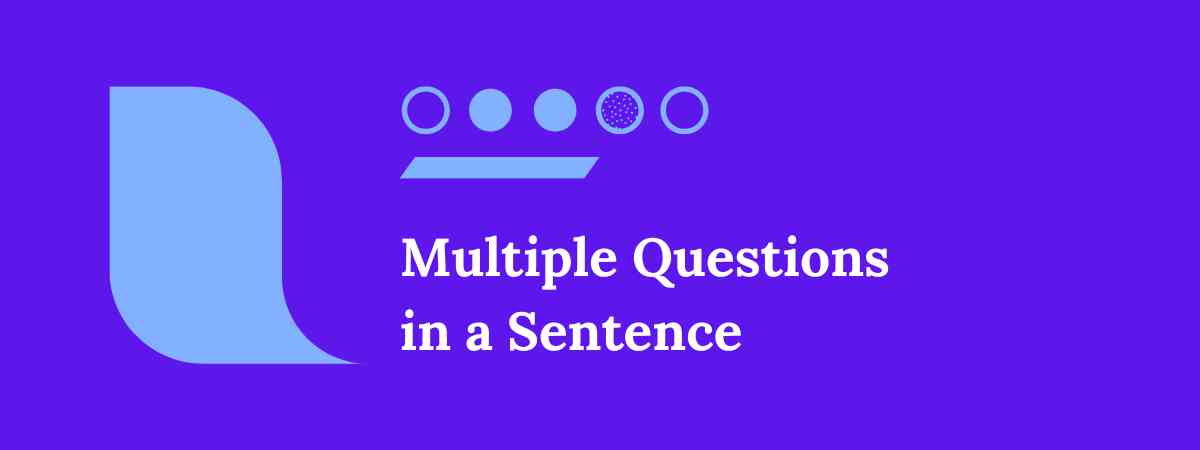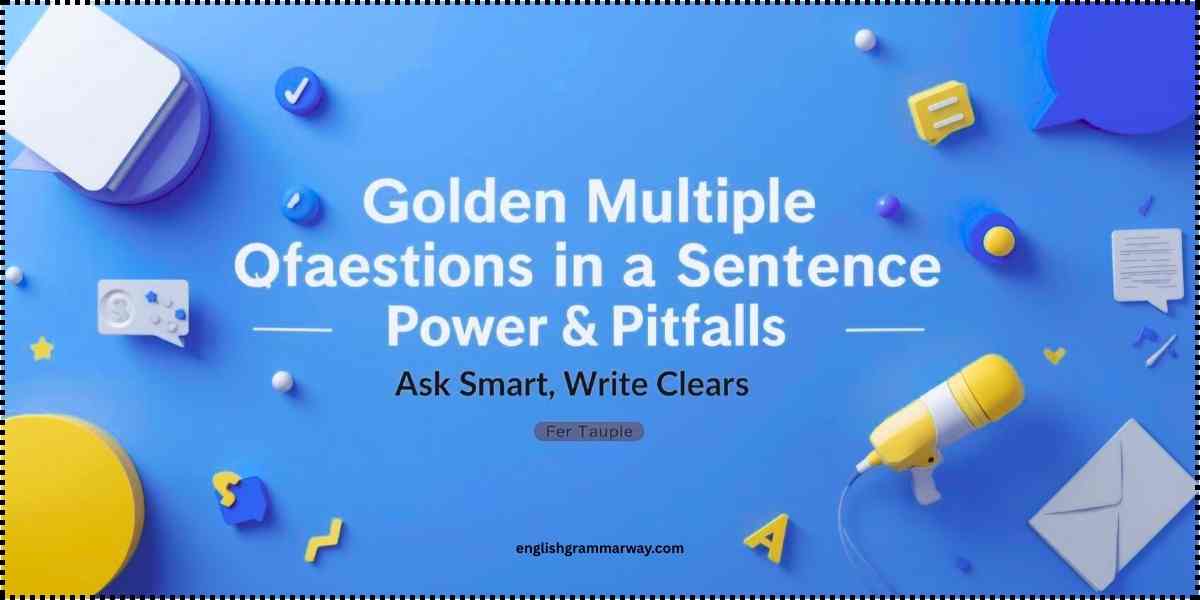Have you ever wondered if it is possible to put multiple questions in a sentence without confusing the reader? Many English learners, and even teachers, often face this challenge. Understanding how to ask several questions clearly is an essential skill for effective communication.
Writing clear questions is important in essays, daily conversations, and formal writing. When used correctly, multiple questions in a sentence can add depth and variety to your language. However, if misused, they can make your writing confusing and hard to follow.
In this blog, we will explore how to use multiple questions in a sentence effectively. You will find practical tips, clear examples, and easy-to-follow guidelines that will help you make your questions stronger, more precise, and easier for your audience to understand.
Why Understanding Multiple Questions in a Sentence Matters
Placing multiple questions in a sentence can help writers express curiosity, explore different ideas, or show emotions like doubt or excitement. For learners, this skill is important because it teaches how to combine thoughts in a natural way. For teachers, it offers tools to guide students in both spoken and written English.
Benefits for English Learners
- Encourages creative thinking
- Helps practice sentence variety
- Improves daily communication skills
Benefits for Teachers
- Provides engaging grammar lessons
- Makes students aware of common mistakes
- Supports better essay and writing practice
What Are Multiple Questions in a Sentence
Multiple questions in a sentence occur when a writer or speaker asks more than one question within the same sentence. For example:
- Who is coming to the meeting, and will they bring the documents?
- Did she call you, or did you call her first?
These examples show how different ideas can be connected to form a compound structure.
Common Ways to Use Multiple Questions in a Sentence
Using Conjunctions
Conjunctions like and, or, and but help connect two or more questions smoothly.
Example: Are you going to the party, or will you stay home?
Using Question Tags
Adding a tag at the end creates a quick second question.
Example: You finished the project, didn’t you?
Using Alternatives
Sometimes a sentence presents choices in the form of questions.
Example: Should we start now, or would you prefer to wait?
Asking Multiple Questions at Once: Helpful or Harmful
Many learners try asking multiple questions at once during writing or speaking. While this shows curiosity, it can also confuse the listener.
Positive Side
- Shows enthusiasm
- Helps cover more than one idea quickly
- Useful in conversations or debates
Negative Side
- Can overwhelm readers or listeners
- Reduces clarity
- May sound unprofessional in formal writing
Example: What do you think of the book, and did you enjoy the ending?
This works in casual speech but may not suit academic essays.
Compound Questions in English
Compound questions are a special type of multiple-choice question in a sentence. They join two related questions into one structure.
Example: Where is the train going, and when will it arrive?
Rules to Remember
- Keep both questions connected logically.
- Use commas for clarity.
- Do not overload the sentence with too many questions.
Question Sentence Examples for Students
Here are some examples learners can practice:
- Will you take the exam, or will you skip it this year?
- Who is your favorite author, and why do you like their style?
- Do you want tea, or should I make coffee instead?
- How does this rule apply, and where can it be used in writing?
- Are you tired, or are you just pretending?
These examples show different patterns you can use to build confidence.
Writing Questions Correctly in Essays
Students often try to use multiple questions in essays to sound creative. While this can work, it requires balance. Too many questions can weaken an argument.
Tips for Essays
- Use one strong question per paragraph.
- If combining, connect the questions with and/or.
- Avoid mixing unrelated questions in one sentence.
Example for essays: How does the author show conflict, and why is it important for the main theme?
English Grammar Questions Teachers Should Emphasize
Teachers should remind students that grammar rules still apply when writing multiple questions in a sentence. Incorrect punctuation or poor word order can make the sentence unclear.
Key Points to Teach
- Place a question mark at the end of the sentence, not after each part.
- Use subject-verb agreement correctly.
- Keep the sentence concise to avoid confusion.
Common Mistakes with Multiple Questions in a Sentence
Overloading a Sentence
Bad Example: Where are you going, what time will you return, who are you meeting, and how long will it take?
Better Example: Where are you going, and what time will you return?
Mixing Formal and Informal Tone
Bad Example: Did you complete the report? And by the way, are you hungry?
Better Example: Did you complete the report, and when will you send it?
Forgetting Parallel Structure
Bad Example: Will you join the group, or stay home?
Better Example: Will you join the group, or will you stay home?
Practical Exercises for Learners
Here are some practice activities you can try today:
- Combine two short questions into one sentence.
Example: Where is the library? When does it open?
Combined: Where is the library, and when does it open? - Rewrite a confusing question into a clear version.
Example: Where are you going, when, who with?
Correct: Where are you going, and who will go with you? - Write three compound questions for daily conversation.
These exercises will make learners confident in both grammar and writing.
Why Multiple Questions in a Sentence Can Show Power and Pitfalls
The power of this structure lies in its ability to express curiosity and depth. It allows writers to engage readers and open discussions. However, the pitfalls appear when writers lose clarity or overwhelm their audience. Balance is the secret to success.
Advanced Rules for Multiple Questions in a Sentence
Once you know the basics, it is time to move toward advanced usage. Many learners stop at simple compound questions, but advanced writers and speakers use these structures to persuade, analyze, and even challenge ideas.
Use in Academic Writing
In essays or research papers, you can use multiple questions in a sentence to introduce complex ideas. This style works well in introductions or when presenting arguments.
Example: How does climate change affect agriculture, and what solutions can policymakers design?
Use in Creative Writing
Storytellers often use multiple questions in a sentence to show a character’s confusion or curiosity.
Example: Why did she leave, where did she go, and will she ever come back?
This shows emotion and depth while keeping the reader engaged.
Use in Public Speaking
When giving speeches, rhetorical questions can be combined for impact.
Example: Who benefits from this system, who suffers, and what can we do to change it?
This makes the audience think critically.
Exercises for Teachers to Use in Class
Teachers can use targeted activities to help students master multiple questions in a sentence.
Group Practice
Ask students to write two simple questions and then join them into one sentence.
Example: What is your favorite subject? Why do you like it?
Combined: What is your favorite subject, and why do you like it?
Correction Activity
Provide examples with mistakes and ask learners to fix them.
Bad Example: Did you study hard, and passing the exam?
Corrected: Did you study hard, and did you pass the exam?
Creative Challenge
Encourage students to write dialogues using multiple questions in a sentence. This helps them see how the structure works in real conversations.
Frequently Asked Questions
Can you use more than two questions in one sentence?
Yes, you can, but clarity should be your top priority. Using three or more questions in one sentence often makes it difficult to read. Keep it simple.
Should each question have its own question mark?
No. In English grammar, only one question mark is used at the end, even when writing multiple questions in a sentence.
Is it acceptable in formal writing?
Yes, but it should be used carefully. Academic essays may allow one or two compound questions, but they should not replace clear statements.
What is the difference between compound and multiple questions in a sentence?
A compound question connects two or more related questions with conjunctions. Multiple questions in a sentence is a broader idea that includes compound questions, question tags, and other structures.
Extra Examples for Daily Practice
To build confidence, here are more practice examples you can try today:
- Will you join us for lunch, or would you rather eat later?
- Who is calling, and why do they need to speak to you now?
- Are you free tomorrow, or should I schedule it for next week?
- Did you enjoy the film, and what did you think of the ending?
- How can students improve their writing, and where can they find the best resources?
- Are you interested in grammar, or do you prefer vocabulary lessons?
- Where do you usually study, and how do you stay focused?
- Do you like reading stories, or do you enjoy writing them more?
- Will we succeed with this plan, or should we change our approach?
- How will this decision affect us, and what can we do to prepare?
These examples show that multiple questions in a sentence can be applied in casual conversations, classrooms, and professional writing.
Power Strategies to Master Multiple Questions in a Sentence
Keep Sentences Short
Do not combine too many ideas at once. A sentence with two clear questions is more effective than one overloaded with four or five.
Use Parallel Structure
Both questions should follow the same pattern for balance.
Example: Will you study English, or will you learn French?
Focus on Purpose
Ask yourself: Am I using multiple questions in a sentence to add value, or just to sound complex? If it does not improve clarity, avoid it.
Read Aloud
If a sentence sounds confusing when read aloud, simplify it. This is a quick way to test clarity.
Advanced Writing Task for Learners
Here is a writing challenge you can try:
Write a short paragraph (4–5 sentences) where you ask at least three compound questions. Then, rewrite the same paragraph with simpler, clearer sentences. Compare the two versions and decide which one is easier to read.
This task helps learners notice the power and pitfalls of multiple questions in a sentence.
Key Takeaways
- Multiple questions in a sentence allow writers to explore ideas deeply.
- Use conjunctions like and and or to connect questions smoothly.
- Keep grammar rules in mind: one question mark, correct word order, and parallel structure.
- Teachers should design activities that encourage both creativity and clarity.
- Writers should always balance power with simplicity to avoid pitfalls.
Cultural Use of Multiple Questions in a Sentence
Different cultures use questioning styles in unique ways.
- In Western writing, multiple questions in a sentence are often used in debates, speeches, or essays to strengthen arguments.
- In Eastern traditions, such as storytelling or poetry, questions are sometimes used together to create rhythm and curiosity.
- In modern media, journalists often use this method to grab attention: What happened, why did it matter, and how will it affect us?
Understanding these differences can help learners see how versatile this structure is.
Psychological Effect of Asking More Than One Question
When someone asks multiple questions in a sentence, it has a special psychological effect. It can:
- Show genuine curiosity
- Pressure the listener to think harder
- Express urgency or emotion
- Create a feeling of connection by covering different aspects of the same idea
For example, imagine a teacher asking: Where did you find the answer, and how confident are you about it? This makes students think more critically.
Advanced Examples for Academic Writing
Students preparing essays, research papers, or speeches can benefit from mastering this skill.
- How does technology affect education, and what strategies can schools adopt to balance digital learning?
- Why is environmental protection urgent, and what role should governments play?
- Who benefits from globalization, and who is left behind?
Each of these examples uses multiple questions in a sentence to invite deeper analysis.
Common Student Struggles with Multiple Questions in a Sentence
Even after learning the rules, students face challenges.
1. Overuse
Students often believe that adding many questions shows intelligence. Instead, it creates confusion.
2. Wrong Punctuation
Many learners put several question marks inside one sentence. Correct grammar requires only one.
3. Lack of Balance
Sometimes, one part of the sentence is a full question, but the other is incomplete. This breaks clarity.
Example of error: Will you join us, or thinking of staying?
Correct form: Will you join us, or will you stay?
Practical Classroom Strategies
Teachers can guide learners by designing exercises around real-life situations.
- Role Play: Students take turns asking multiple questions in a sentence during a mock interview.
- Group Writing: Teams write dialogues using this structure.
- Peer Editing: Learners exchange work and identify mistakes in each other’s sentences.
These methods make grammar learning more interactive.
Multiple Questions in Everyday Conversations
We often use this structure without realizing it.
Examples:
- Are you hungry, or should we wait for dinner?
- Did you call your parents, and what did they say?
- Where is your notebook, and why didn’t you bring it?
Such sentences sound natural in spoken English and help conversations flow smoothly.
Using Multiple Questions in Storytelling
Authors and speakers sometimes add layers of mystery by using multiple questions in a sentence.
Example: Who was knocking at the door? Why were they here so late, and what would happen next?
This makes readers eager to continue. Students can practice this technique to improve creative writing.
Multiple Questions in Professional Settings
In workplaces, asking multiple questions in a sentence can make meetings more productive.
Example: What are the project goals, and who will be responsible for each task?
This keeps communication clear and ensures everyone understands. However, in professional settings, the questions should be precise and not overwhelming.
Tips for Learners to Master This Skill
- Start Simple: Practice with two short questions.
- Check Grammar: Make sure verbs and subjects are consistent.
- Use in Writing and Speaking: Balance practice between both.
- Seek Feedback: Ask teachers or peers to review your sentences.
- Be Mindful of Audience: Casual tone for friends, formal tone for essays.
Why Teachers Should Focus on This Topic
Many teachers skip over this structure, but it is valuable for learners. It improves essay writing, builds speaking confidence, and helps with creative expression. By teaching multiple questions in a sentence, teachers also prepare students for real-life communication.
Conclusion
Using multiple questions in a sentence can transform the way learners write and speak. It allows a single sentence to explore different angles, capture attention, and spark curiosity. When used correctly, it brings clarity and richness to communication instead of confusion.
The real challenge lies in balance. A sentence with two clear questions can be powerful, but one packed with too many questions often feels heavy and unclear. Learners should remember that quality matters more than quantity. Teachers can guide students to use this structure effectively, ensuring every question is meaningful and connected.
Like every skill in English, mastering multiple questions in a sentence comes through practice. Learners should try examples in essays, conversations, and even creative writing. Teachers can provide interactive exercises to make the practice fun and practical. With patience and regular effort, this structure will soon become a natural tool for confident expression.



